Environmental Factors Affecting Older People's Community Participation
VerifiedAdded on 2020/03/13
|5
|1576
|44
Report
AI Summary
This report, focusing on health science, investigates the environmental factors that influence the participation of older people in their communities. It utilizes the WHO-ICF framework to define disability and its multifaceted dimensions, emphasizing the dynamic interaction between health, environmental, and personal factors. The study explores factors like socioeconomic status, social networks (assessed via the CLSNS), and self-perceived socioeconomic status (using the MacArthur Scale) to determine their association with participation restrictions. Demographic details, including age, gender, health conditions, and comorbidity levels (evaluated using the C-CCI), are also considered. The report highlights the participants' desire for solutions related to healthcare and integration with younger generations, emphasizing the importance of accessible public services and technology. The findings suggest the need for inclusive solutions and further research to address the challenges faced by older adults in community involvement, promoting their active participation and well-being. The report references key studies and frameworks, including those by the Australian Institute of Health and Welfare, Belsky et al., Berry, Faulkner, and the World Health Organization.
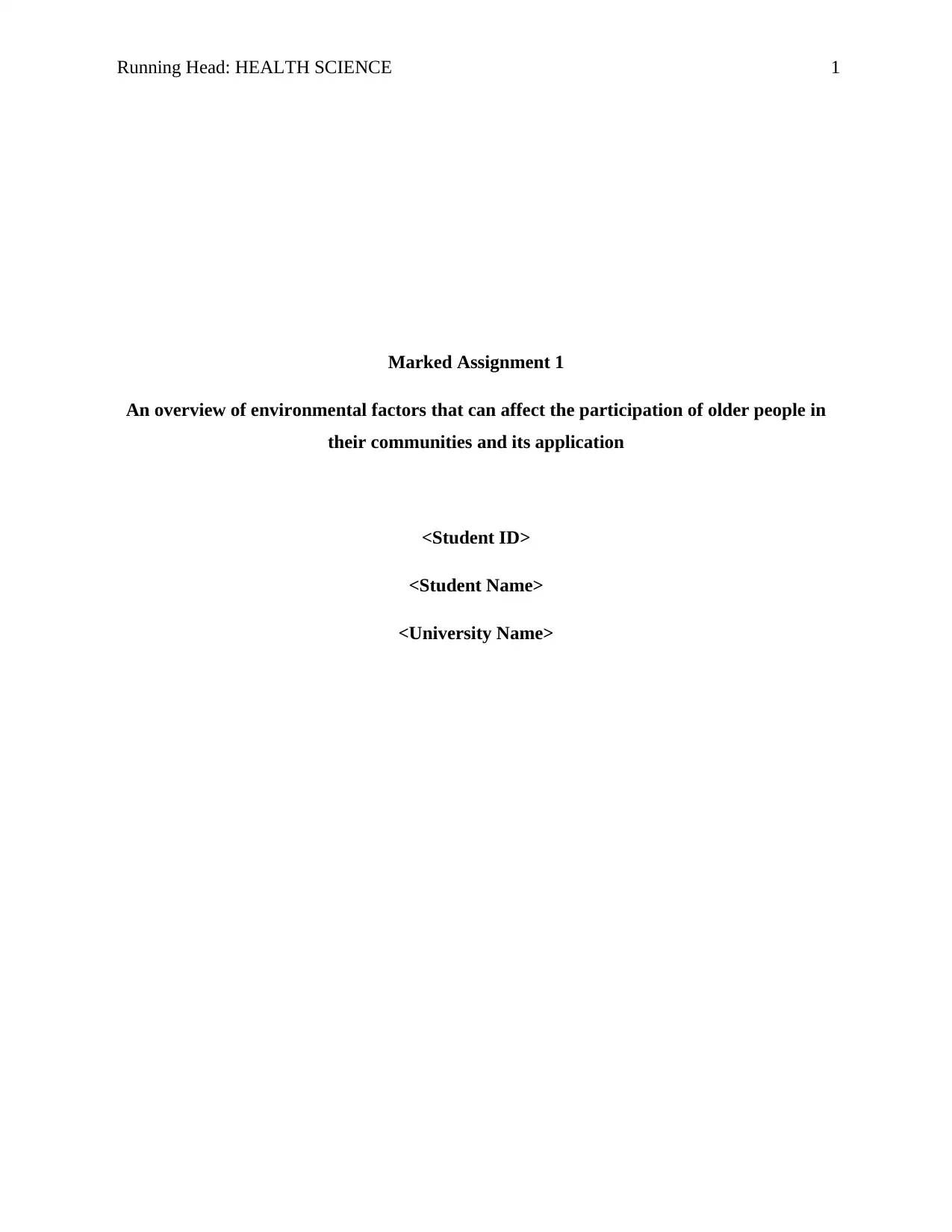
Running Head: HEALTH SCIENCE 1
Marked Assignment 1
An overview of environmental factors that can affect the participation of older people in
their communities and its application
<Student ID>
<Student Name>
<University Name>
Marked Assignment 1
An overview of environmental factors that can affect the participation of older people in
their communities and its application
<Student ID>
<Student Name>
<University Name>
Paraphrase This Document
Need a fresh take? Get an instant paraphrase of this document with our AI Paraphraser
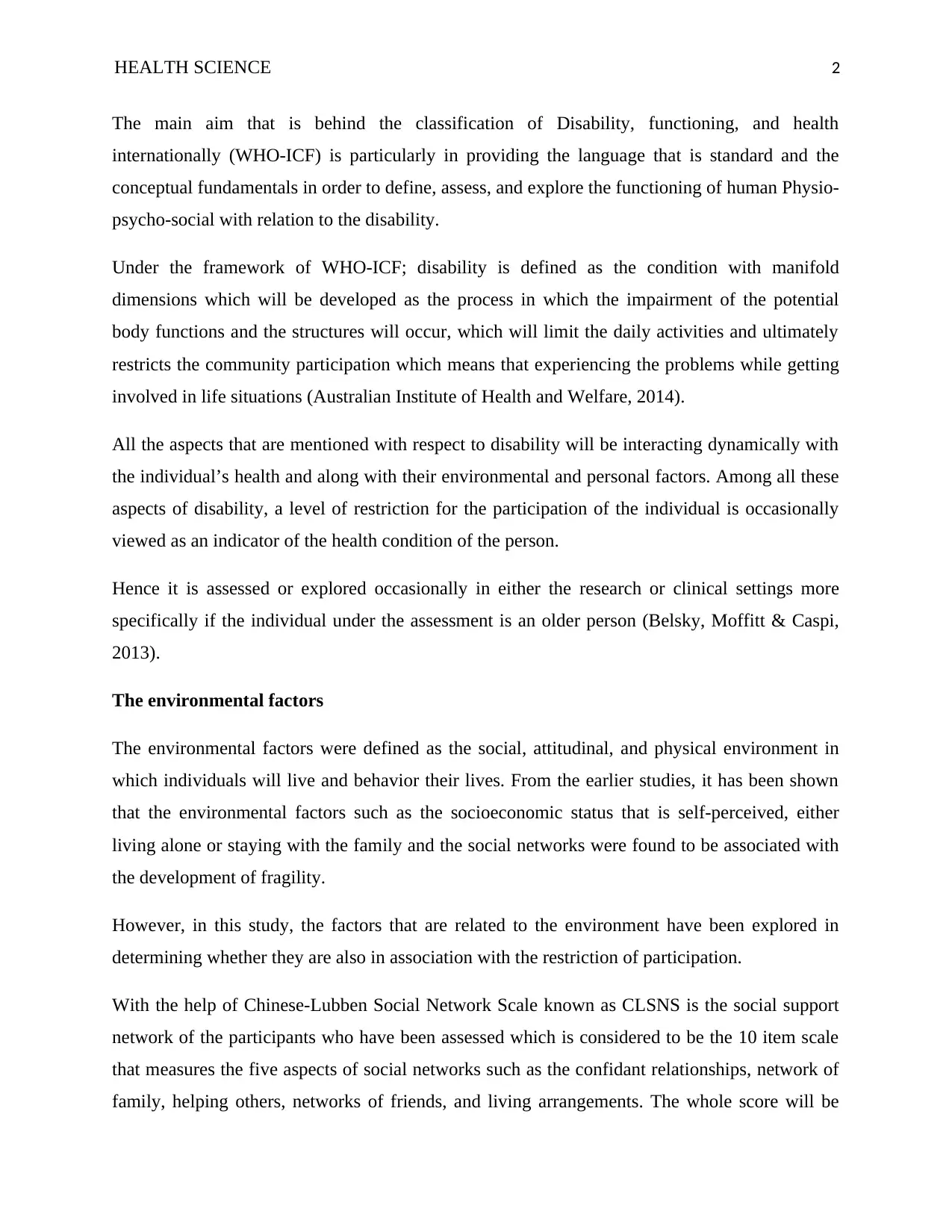
HEALTH SCIENCE 2
The main aim that is behind the classification of Disability, functioning, and health
internationally (WHO-ICF) is particularly in providing the language that is standard and the
conceptual fundamentals in order to define, assess, and explore the functioning of human Physio-
psycho-social with relation to the disability.
Under the framework of WHO-ICF; disability is defined as the condition with manifold
dimensions which will be developed as the process in which the impairment of the potential
body functions and the structures will occur, which will limit the daily activities and ultimately
restricts the community participation which means that experiencing the problems while getting
involved in life situations (Australian Institute of Health and Welfare, 2014).
All the aspects that are mentioned with respect to disability will be interacting dynamically with
the individual’s health and along with their environmental and personal factors. Among all these
aspects of disability, a level of restriction for the participation of the individual is occasionally
viewed as an indicator of the health condition of the person.
Hence it is assessed or explored occasionally in either the research or clinical settings more
specifically if the individual under the assessment is an older person (Belsky, Moffitt & Caspi,
2013).
The environmental factors
The environmental factors were defined as the social, attitudinal, and physical environment in
which individuals will live and behavior their lives. From the earlier studies, it has been shown
that the environmental factors such as the socioeconomic status that is self-perceived, either
living alone or staying with the family and the social networks were found to be associated with
the development of fragility.
However, in this study, the factors that are related to the environment have been explored in
determining whether they are also in association with the restriction of participation.
With the help of Chinese-Lubben Social Network Scale known as CLSNS is the social support
network of the participants who have been assessed which is considered to be the 10 item scale
that measures the five aspects of social networks such as the confidant relationships, network of
family, helping others, networks of friends, and living arrangements. The whole score will be
The main aim that is behind the classification of Disability, functioning, and health
internationally (WHO-ICF) is particularly in providing the language that is standard and the
conceptual fundamentals in order to define, assess, and explore the functioning of human Physio-
psycho-social with relation to the disability.
Under the framework of WHO-ICF; disability is defined as the condition with manifold
dimensions which will be developed as the process in which the impairment of the potential
body functions and the structures will occur, which will limit the daily activities and ultimately
restricts the community participation which means that experiencing the problems while getting
involved in life situations (Australian Institute of Health and Welfare, 2014).
All the aspects that are mentioned with respect to disability will be interacting dynamically with
the individual’s health and along with their environmental and personal factors. Among all these
aspects of disability, a level of restriction for the participation of the individual is occasionally
viewed as an indicator of the health condition of the person.
Hence it is assessed or explored occasionally in either the research or clinical settings more
specifically if the individual under the assessment is an older person (Belsky, Moffitt & Caspi,
2013).
The environmental factors
The environmental factors were defined as the social, attitudinal, and physical environment in
which individuals will live and behavior their lives. From the earlier studies, it has been shown
that the environmental factors such as the socioeconomic status that is self-perceived, either
living alone or staying with the family and the social networks were found to be associated with
the development of fragility.
However, in this study, the factors that are related to the environment have been explored in
determining whether they are also in association with the restriction of participation.
With the help of Chinese-Lubben Social Network Scale known as CLSNS is the social support
network of the participants who have been assessed which is considered to be the 10 item scale
that measures the five aspects of social networks such as the confidant relationships, network of
family, helping others, networks of friends, and living arrangements. The whole score will be
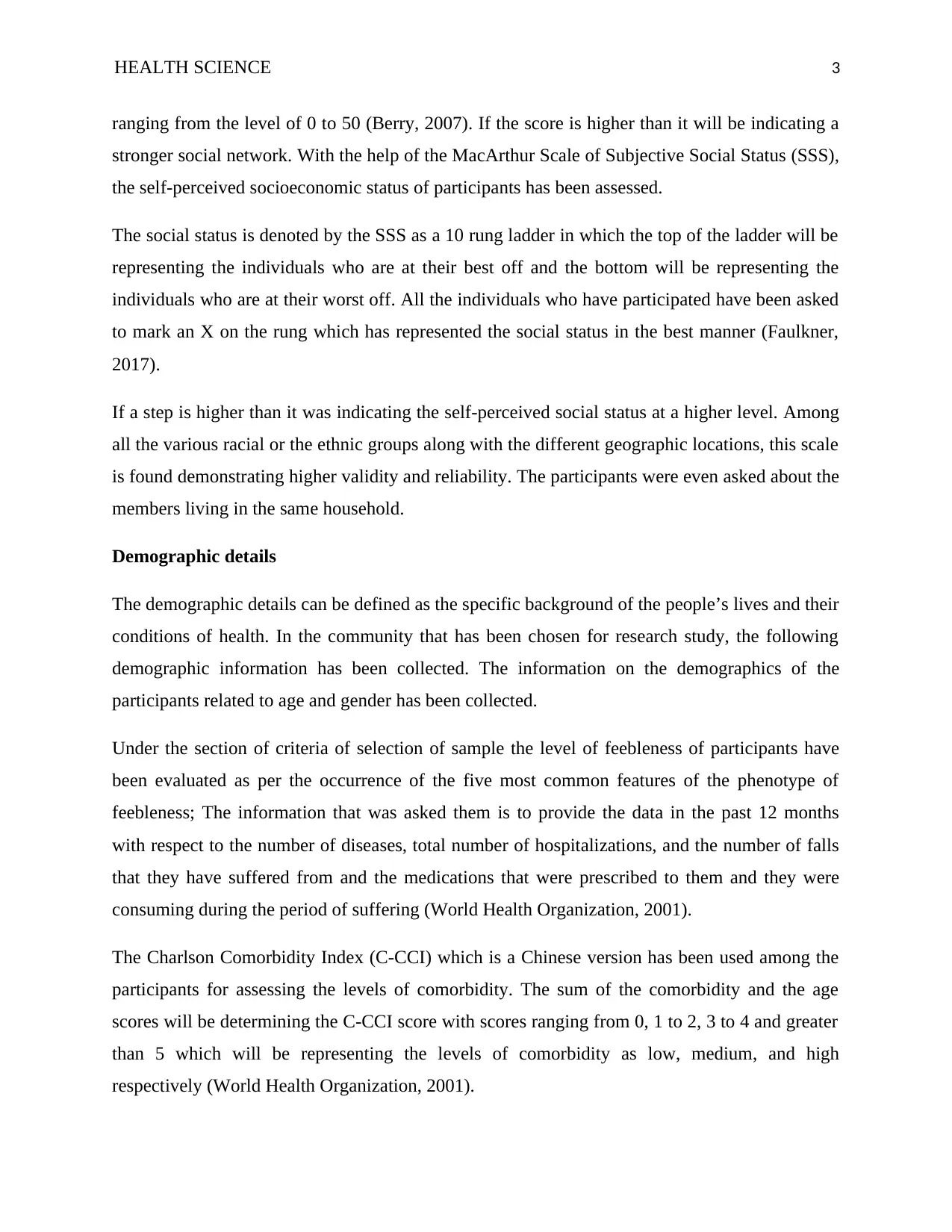
HEALTH SCIENCE 3
ranging from the level of 0 to 50 (Berry, 2007). If the score is higher than it will be indicating a
stronger social network. With the help of the MacArthur Scale of Subjective Social Status (SSS),
the self-perceived socioeconomic status of participants has been assessed.
The social status is denoted by the SSS as a 10 rung ladder in which the top of the ladder will be
representing the individuals who are at their best off and the bottom will be representing the
individuals who are at their worst off. All the individuals who have participated have been asked
to mark an X on the rung which has represented the social status in the best manner (Faulkner,
2017).
If a step is higher than it was indicating the self-perceived social status at a higher level. Among
all the various racial or the ethnic groups along with the different geographic locations, this scale
is found demonstrating higher validity and reliability. The participants were even asked about the
members living in the same household.
Demographic details
The demographic details can be defined as the specific background of the people’s lives and their
conditions of health. In the community that has been chosen for research study, the following
demographic information has been collected. The information on the demographics of the
participants related to age and gender has been collected.
Under the section of criteria of selection of sample the level of feebleness of participants have
been evaluated as per the occurrence of the five most common features of the phenotype of
feebleness; The information that was asked them is to provide the data in the past 12 months
with respect to the number of diseases, total number of hospitalizations, and the number of falls
that they have suffered from and the medications that were prescribed to them and they were
consuming during the period of suffering (World Health Organization, 2001).
The Charlson Comorbidity Index (C-CCI) which is a Chinese version has been used among the
participants for assessing the levels of comorbidity. The sum of the comorbidity and the age
scores will be determining the C-CCI score with scores ranging from 0, 1 to 2, 3 to 4 and greater
than 5 which will be representing the levels of comorbidity as low, medium, and high
respectively (World Health Organization, 2001).
ranging from the level of 0 to 50 (Berry, 2007). If the score is higher than it will be indicating a
stronger social network. With the help of the MacArthur Scale of Subjective Social Status (SSS),
the self-perceived socioeconomic status of participants has been assessed.
The social status is denoted by the SSS as a 10 rung ladder in which the top of the ladder will be
representing the individuals who are at their best off and the bottom will be representing the
individuals who are at their worst off. All the individuals who have participated have been asked
to mark an X on the rung which has represented the social status in the best manner (Faulkner,
2017).
If a step is higher than it was indicating the self-perceived social status at a higher level. Among
all the various racial or the ethnic groups along with the different geographic locations, this scale
is found demonstrating higher validity and reliability. The participants were even asked about the
members living in the same household.
Demographic details
The demographic details can be defined as the specific background of the people’s lives and their
conditions of health. In the community that has been chosen for research study, the following
demographic information has been collected. The information on the demographics of the
participants related to age and gender has been collected.
Under the section of criteria of selection of sample the level of feebleness of participants have
been evaluated as per the occurrence of the five most common features of the phenotype of
feebleness; The information that was asked them is to provide the data in the past 12 months
with respect to the number of diseases, total number of hospitalizations, and the number of falls
that they have suffered from and the medications that were prescribed to them and they were
consuming during the period of suffering (World Health Organization, 2001).
The Charlson Comorbidity Index (C-CCI) which is a Chinese version has been used among the
participants for assessing the levels of comorbidity. The sum of the comorbidity and the age
scores will be determining the C-CCI score with scores ranging from 0, 1 to 2, 3 to 4 and greater
than 5 which will be representing the levels of comorbidity as low, medium, and high
respectively (World Health Organization, 2001).
⊘ This is a preview!⊘
Do you want full access?
Subscribe today to unlock all pages.

Trusted by 1+ million students worldwide
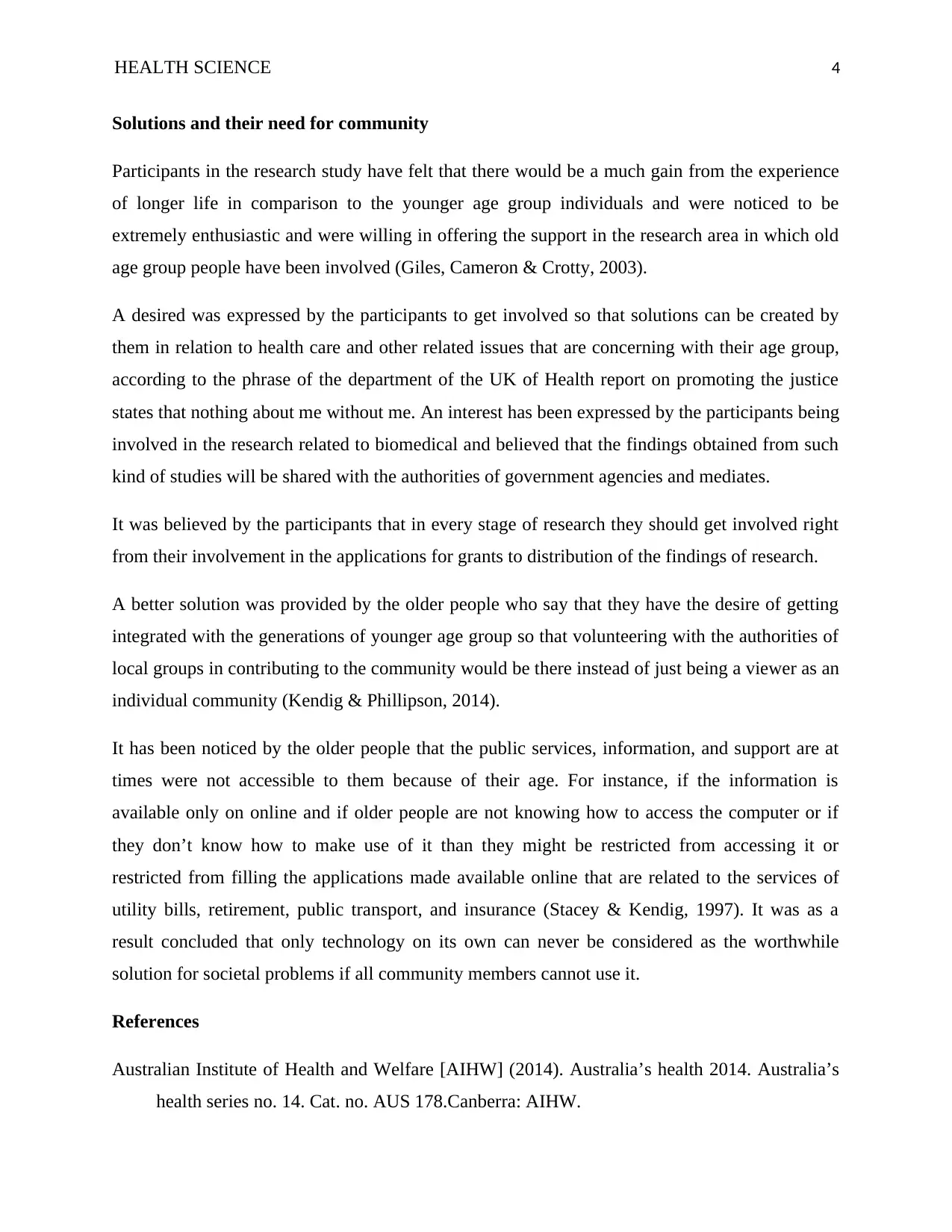
HEALTH SCIENCE 4
Solutions and their need for community
Participants in the research study have felt that there would be a much gain from the experience
of longer life in comparison to the younger age group individuals and were noticed to be
extremely enthusiastic and were willing in offering the support in the research area in which old
age group people have been involved (Giles, Cameron & Crotty, 2003).
A desired was expressed by the participants to get involved so that solutions can be created by
them in relation to health care and other related issues that are concerning with their age group,
according to the phrase of the department of the UK of Health report on promoting the justice
states that nothing about me without me. An interest has been expressed by the participants being
involved in the research related to biomedical and believed that the findings obtained from such
kind of studies will be shared with the authorities of government agencies and mediates.
It was believed by the participants that in every stage of research they should get involved right
from their involvement in the applications for grants to distribution of the findings of research.
A better solution was provided by the older people who say that they have the desire of getting
integrated with the generations of younger age group so that volunteering with the authorities of
local groups in contributing to the community would be there instead of just being a viewer as an
individual community (Kendig & Phillipson, 2014).
It has been noticed by the older people that the public services, information, and support are at
times were not accessible to them because of their age. For instance, if the information is
available only on online and if older people are not knowing how to access the computer or if
they don’t know how to make use of it than they might be restricted from accessing it or
restricted from filling the applications made available online that are related to the services of
utility bills, retirement, public transport, and insurance (Stacey & Kendig, 1997). It was as a
result concluded that only technology on its own can never be considered as the worthwhile
solution for societal problems if all community members cannot use it.
References
Australian Institute of Health and Welfare [AIHW] (2014). Australia’s health 2014. Australia’s
health series no. 14. Cat. no. AUS 178.Canberra: AIHW.
Solutions and their need for community
Participants in the research study have felt that there would be a much gain from the experience
of longer life in comparison to the younger age group individuals and were noticed to be
extremely enthusiastic and were willing in offering the support in the research area in which old
age group people have been involved (Giles, Cameron & Crotty, 2003).
A desired was expressed by the participants to get involved so that solutions can be created by
them in relation to health care and other related issues that are concerning with their age group,
according to the phrase of the department of the UK of Health report on promoting the justice
states that nothing about me without me. An interest has been expressed by the participants being
involved in the research related to biomedical and believed that the findings obtained from such
kind of studies will be shared with the authorities of government agencies and mediates.
It was believed by the participants that in every stage of research they should get involved right
from their involvement in the applications for grants to distribution of the findings of research.
A better solution was provided by the older people who say that they have the desire of getting
integrated with the generations of younger age group so that volunteering with the authorities of
local groups in contributing to the community would be there instead of just being a viewer as an
individual community (Kendig & Phillipson, 2014).
It has been noticed by the older people that the public services, information, and support are at
times were not accessible to them because of their age. For instance, if the information is
available only on online and if older people are not knowing how to access the computer or if
they don’t know how to make use of it than they might be restricted from accessing it or
restricted from filling the applications made available online that are related to the services of
utility bills, retirement, public transport, and insurance (Stacey & Kendig, 1997). It was as a
result concluded that only technology on its own can never be considered as the worthwhile
solution for societal problems if all community members cannot use it.
References
Australian Institute of Health and Welfare [AIHW] (2014). Australia’s health 2014. Australia’s
health series no. 14. Cat. no. AUS 178.Canberra: AIHW.
Paraphrase This Document
Need a fresh take? Get an instant paraphrase of this document with our AI Paraphraser
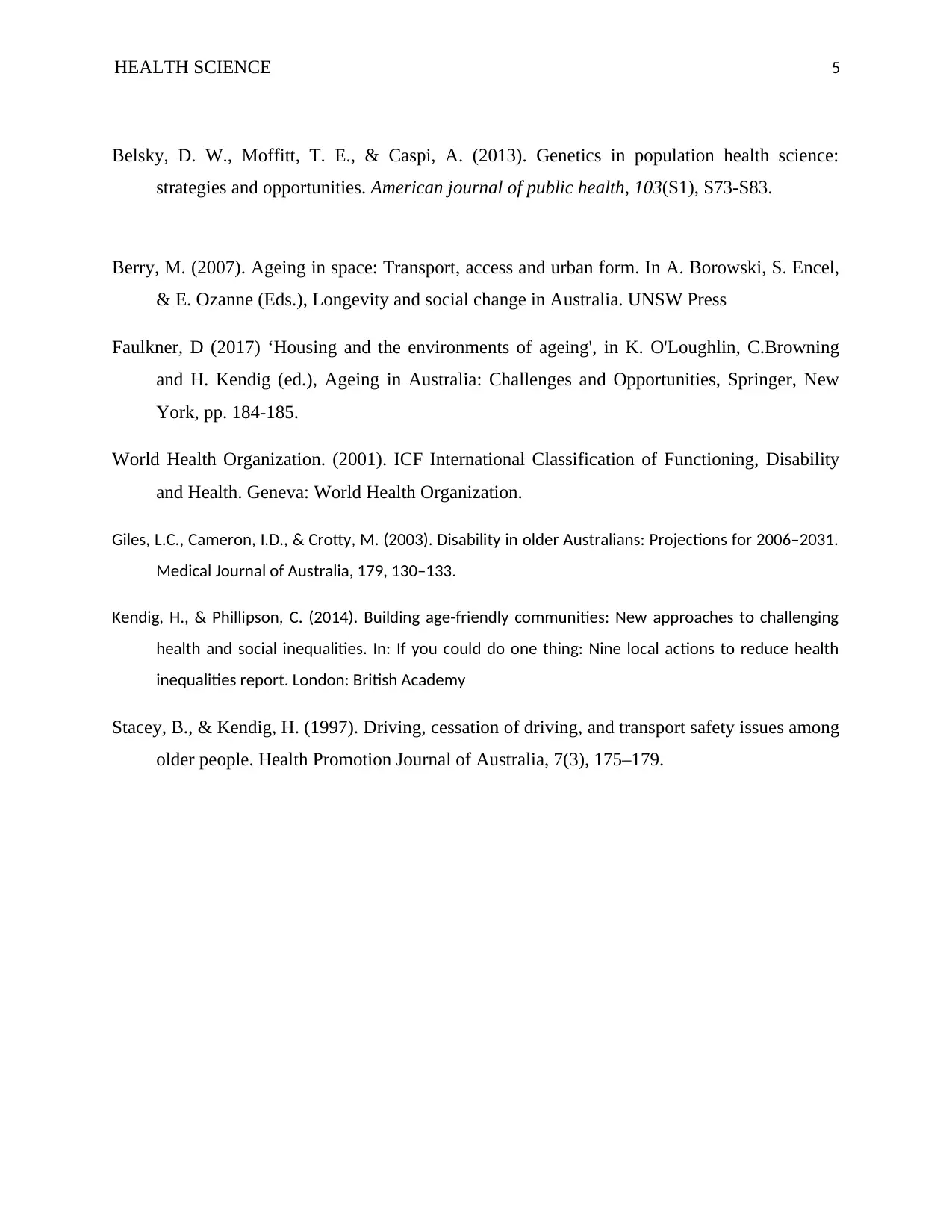
HEALTH SCIENCE 5
Belsky, D. W., Moffitt, T. E., & Caspi, A. (2013). Genetics in population health science:
strategies and opportunities. American journal of public health, 103(S1), S73-S83.
Berry, M. (2007). Ageing in space: Transport, access and urban form. In A. Borowski, S. Encel,
& E. Ozanne (Eds.), Longevity and social change in Australia. UNSW Press
Faulkner, D (2017) ‘Housing and the environments of ageing', in K. O'Loughlin, C.Browning
and H. Kendig (ed.), Ageing in Australia: Challenges and Opportunities, Springer, New
York, pp. 184-185.
World Health Organization. (2001). ICF International Classification of Functioning, Disability
and Health. Geneva: World Health Organization.
Giles, L.C., Cameron, I.D., & Crotty, M. (2003). Disability in older Australians: Projections for 2006–2031.
Medical Journal of Australia, 179, 130–133.
Kendig, H., & Phillipson, C. (2014). Building age-friendly communities: New approaches to challenging
health and social inequalities. In: If you could do one thing: Nine local actions to reduce health
inequalities report. London: British Academy
Stacey, B., & Kendig, H. (1997). Driving, cessation of driving, and transport safety issues among
older people. Health Promotion Journal of Australia, 7(3), 175–179.
Belsky, D. W., Moffitt, T. E., & Caspi, A. (2013). Genetics in population health science:
strategies and opportunities. American journal of public health, 103(S1), S73-S83.
Berry, M. (2007). Ageing in space: Transport, access and urban form. In A. Borowski, S. Encel,
& E. Ozanne (Eds.), Longevity and social change in Australia. UNSW Press
Faulkner, D (2017) ‘Housing and the environments of ageing', in K. O'Loughlin, C.Browning
and H. Kendig (ed.), Ageing in Australia: Challenges and Opportunities, Springer, New
York, pp. 184-185.
World Health Organization. (2001). ICF International Classification of Functioning, Disability
and Health. Geneva: World Health Organization.
Giles, L.C., Cameron, I.D., & Crotty, M. (2003). Disability in older Australians: Projections for 2006–2031.
Medical Journal of Australia, 179, 130–133.
Kendig, H., & Phillipson, C. (2014). Building age-friendly communities: New approaches to challenging
health and social inequalities. In: If you could do one thing: Nine local actions to reduce health
inequalities report. London: British Academy
Stacey, B., & Kendig, H. (1997). Driving, cessation of driving, and transport safety issues among
older people. Health Promotion Journal of Australia, 7(3), 175–179.
1 out of 5
Related Documents
Your All-in-One AI-Powered Toolkit for Academic Success.
+13062052269
info@desklib.com
Available 24*7 on WhatsApp / Email
![[object Object]](/_next/static/media/star-bottom.7253800d.svg)
Unlock your academic potential
Copyright © 2020–2025 A2Z Services. All Rights Reserved. Developed and managed by ZUCOL.





